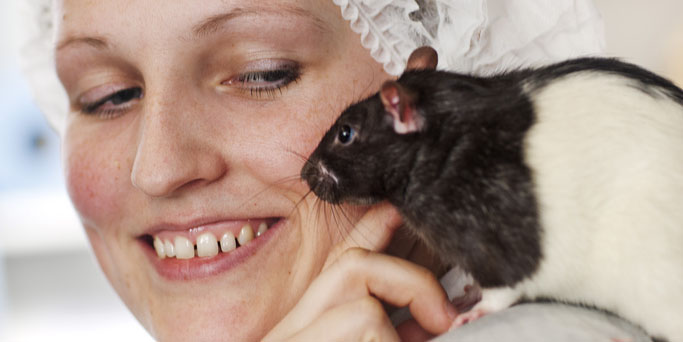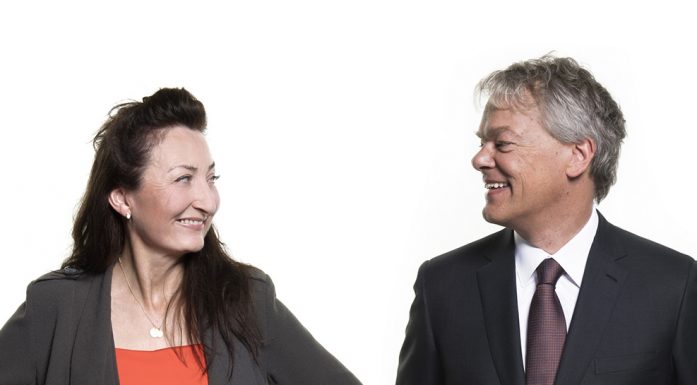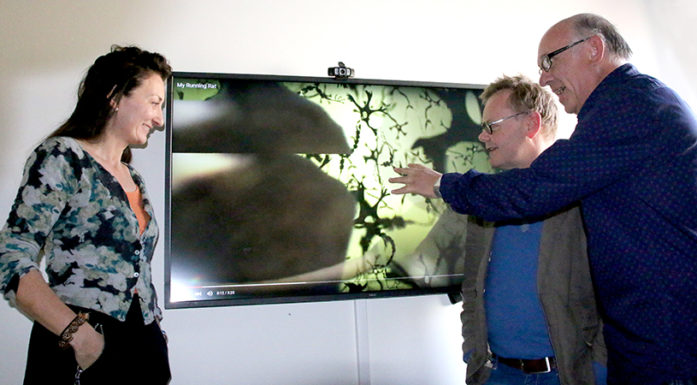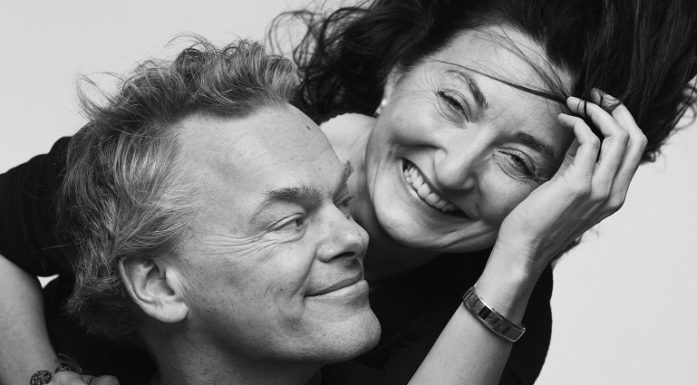Gertrude, Tarzan, and the rest of the Nobel gang
2014 NOBEL PRIZE: Animal welfare is important for Nobel laureates May-Britt and Edvard Moser. Not just because that is how it should be, but also because the researchers get the best results that way.
Gertrude is headed over to see Tarzan in the neighbouring cage. She snuck out of her cage when the door happened to be open, but was quickly apprehended and returned to her own cage. She joins Hjørdis, who also seems to want to take a trip to visit the neighbour next door. Tarzan is clearly popular today.
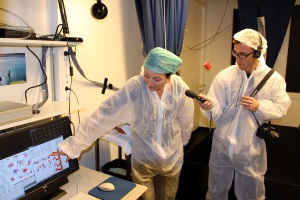
Media interest in the Mosers’ research exploded when the announcement was made earlier this autumn that they had won the Nobel Prize. Here Swedish Radio reporter Björn Guner gets some insights into what researchers can learn from the data collected from a rat’s brain. Photo: Steinar Brandslet/NTNU
Here at the Kavli Institute for Systems Neuroscience in Trondheim all of the laboratory rats have their own name. Every one.
“There are two reasons for this. First, I love animals. Second, we get better results this way,” says May-Britt Moser to all of the journalists who have come to today’s press briefing.
Since the announcement earlier this autumn that she had been awarded the Nobel Prize in Physiology or Medicine along with her husband Edward and mentor John O’Keefe, there have been more than a few media tours around the Kavli Institute. May-Britt Moser is still very willing to talk. Especially when it comes to talking about the animals.
Rats take priority
A good relationship with the rats reduces the animals’ stress and means they behave more naturally and relaxed around people. Animal welfare thus means better research results. The logic is simple. And the opposite also applies: people behave better towards animals they have a relationship with.
“Anyone who has rats here has to cuddle them,” says May-Britt Moser.
She herself is involved in hiring the people who will take care of the animals. You will not get an interview unless you really like animals. Humans must accommodate the animals’ needs, rather than vice versa.
For one reason or another the rat she is holding is named Mai. We probably should have asked why. But May also shares a cage with Gertrude and Hjørdis, two of the other rat celebrities who are often showcased when people come to visit.
AC/DC plays “Back in Black” in the background. Rats in the Moser lab need music too. And toys. The cage contains a Duplo crate, several “floors” and a treadmill.
The Mosers put a great deal of emphasis on animal welfare. Nevertheless, the researchers have been criticized by the Animal Protection Alliance, who do not like animals to be used in these kinds of experiments. At the same time, a number of veterinarians have spoken up in support of the Mosers. The couple has also been nominated for an award from Norecopa, for their good handling of animals. Norecopa is the Norwegian Consensus Platform for the Replacement, Reduction and Refinement of Animal Experiments.
May-Britt Moser would prefer to conduct her research without the use of animals, but it is not possible. In any event, the animals live well. Specially trained veterinary nurses take care of them.
Golden hands
Mai the rat is wearing a small, strange hat.
The Mosers were awarded the Nobel Prize for the discovery of special cells, called grid cells, that constituting a kind of GPS in the brain. Their subsequent research showed how these and another kind of cell called place cells make it possible to determine position and to navigate.
This research requires the scientists to insert hair-thin electrodes into different areas of the animals’ brains to measure activity there.
That’s why some of the rats have the special hats on their heads. The connection is physical, and inserting the electrodes requires precision.
Veterinarians have found that the animals stop noticing their strange headpieces after a while. And since there are no pain receptors in the brain, it does not hurt.
People who are qualified enough to find themselves being interviewed at the Kavli Institute should not be surprised if they are asked whether they do handcrafts.
“People who work here have to have golden hands,” says May-Britt Moser.
Handcrafts or other similar hobbies that require precision are an advantage for the people here, because it means that their fine motor skills are already a little trained up. It takes quite a lot of skill to insert electrodes next to neurons. And there is no room for mistakes.
Everyone who works here must perform at the highest possible level. May-Britt Moser uses the English word “excellence” to describe this demand. You cannot deliver anything other than the best.
May-Britt and Edvard Moser seem to complement each other’s roles. She leads the Centre for Neural Computation at NTNU’s Faculty of Medicine. He is director of the Kavli Institute.
Navigation
John O’Keefe at University College London discovered that a type of nerve cells in a part of the brain called the hippocampus were always active when a rat found itself a particular place in a room. Other neurons were activated when the rat was somewhere else. O’Keefe concluded that these “place cells” formed an internal map of the room.
The Mosers apprenticed briefly with O’Keefe in 1995 to learn how they could study place cell behaviour in the hippocampus. The following year they came to Trondheim.
They discovered “grid cells” in 2005, which along with place cells help us know where we are, where we are going and how to navigate. Their former students Torkel Hafting, Marianne Fyhn and Sturla Molden were also involved in the discovery.
Grid cells are found in the part of the brain called the temporal lobe, or the entorhinal cortex.
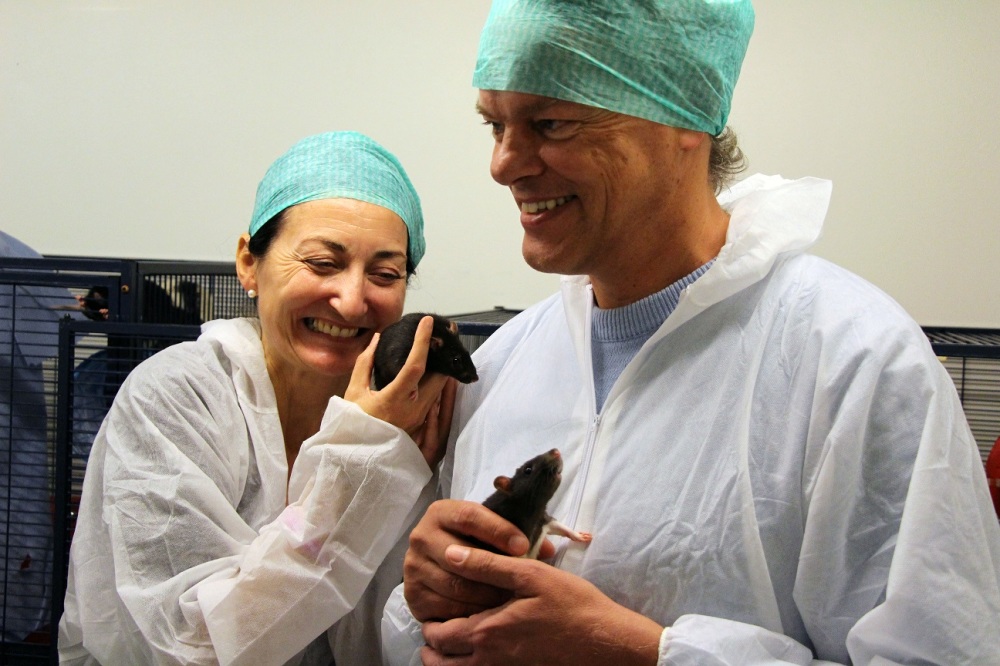
May-Britt Moser (left) and her husband and colleague Edvard and three of their then-graduate students discovered grid cells with the help of laboratory rats Photo: Geir Mogen/NTNU
Chocolate cereal
Fred the rat is at work. The wires that are connected to his head move over him while he runs around a square, open box with black walls.
The instruments that measure the activity in Fred’s brain make a kind of crackling, popping noise while Fred moves around and picks up bits of chocolate cereal that PhD student Tanja Wernle tosses into him.
Each of the “pops” made by the instruments represents a signal from the brain. The monitors show a recording of the activity.
This is fundamental, basic research into the deepest workings of the brain. No cures will directly result from the studies the Mosers do here today. And they themselves rarely talk about how their research could someday make important contributions to curing various disorders affecting the temporal lobe. But if there was any disease that might benefit in the future from their work, it will almost certainly be Alzheimer’s, where one of the earliest symptoms is losing your ability to find your way in familiar places.
Thanks to Jesse Owens
Jesse is a little mouse. He is named after the four time Olympic champion Jesse Owens. This small, furry Jesse also likes to run around. The researchers toss vanilla cookie crumbs into his black box, and Jesse is busy vacuuming them up. The air is full of the crackling from the mouse’s brain activity. Jesse, like his larger rat cousins, is hooked up to the instruments via tiny wires.
“He has golden hands,” says May-Britt Moser of David Rowland from Chicago, who is here as part of a postdoctoral project.
In return for the requirement that their colleagues always deliver at the highest possible level, the Mosers are very generous with sharing the credit for all of the awards they have won over the years.
People who work here can expect to get all the credit for their own work, as well as the respect that comes with having carried out the work in a place that only accepts excellence.
May-Britt Moser is praising someone again. But not a human this time, but Jesse the mouse, who always delivers such good results.
Not a surprise. These are the animals, after all, that they can thank for the Nobel Prize.
